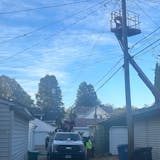Cloudy With Afternoon Snow Friday
Cloudy skies are sticking around on Friday, and we will watch the chance for some snowfall later in the afternoon hours - I'll have more on the snow chances below. Morning temperatures will start in the mid-20s with highs in the mid-30s.
Cloudy skies are expected across the state on Friday, with increasing snow chances into the midday and afternoon hours across northern and western Minnesota. Highs will be in the 20s and 30s across Minnesota for Friday - still 5-15F degrees above average.
_______________________________________________
Closer Look At Friday/Saturday Snowfall
Forecast loop from 6 AM Friday to 6 AM Sunday.
As we head into the weekend, we will be watching two systems cross over the region, leading to periods of light snow in central and southern Minnesota and an extended period of light snow in northern Minnesota. Snow will already start developing as we head into Friday afternoon across central, southern, and western Minnesota, with a period of snow possible for the metro from the late afternoon hours to about midnight Friday Night in the metro. Otherwise, snow continues across the northern half and western third of Minnesota through Friday Night, with that western batch of snow slowly moving eastward across the state on Saturday. It looks like it will reach the metro during the later afternoon hours on Saturday, exiting overnight.
The greatest snow tallies are expected to fall across northern Minnesota, where the light snow will be constant across much of the period. In these areas, a band of 2-5" is expected from Red Lake down to Little Falls eastward to the Arrowhead and northern Wisconsin. Within this area, the heaviest (potentially isolated 5-7" totals) is expected along the Sawtooth Mountains on the North Shore. South toward the metro, snowfall tallies of 0.5-1.25" are expected during the Friday/Friday Night snow (heaviest on the north side of the metro), with another 0.5-1" Saturday/Saturday Night for overall totals around 1-2".
Due to the expected snow of 3-6" across northeastern Minnesota, Winter Weather Advisories have been issued. They go into effect at Noon Friday with the western side of the alerts (Grand Rapids, Hill City areas) ending at 6 PM Saturday and the rest ending at 6 AM Sunday.
_______________________________________________


